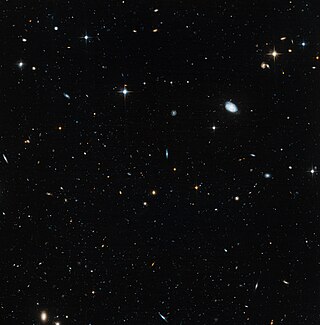Top Qs
Timeline
Chat
Perspective
Leo IV (dwarf galaxy)
Galaxy in the constellation Leo From Wikipedia, the free encyclopedia
Remove ads
Leo IV is a dwarf spheroidal galaxy situated in the Leo constellation, discovered in 2006 in the data obtained by the Sloan Digital Sky Survey.[3] The galaxy is located at the distance of about 160 kpc from the Sun and moves away from the Sun with the velocity of about 130 km/s.[3][5] It is classified as a dwarf spheroidal galaxy (dSph) meaning that it has an approximately round shape with the half-light radius of about 130 pc.[4][note 1]
Leo IV is one of the smallest and faintest satellites of the Milky Way; its integrated luminosity is about 15000 times that of the Sun (absolute visible magnitude of −5.5±0.3), which is much lower than the luminosity of a typical globular cluster.[4] However, its mass is about 1.5 million solar masses, which means that Leo's mass to light ratio is around 150. A high mass to light ratio implies that Leo IV is dominated by the dark matter.[5]
The stellar population of Leo IV consists mainly of old stars formed more than 12 billion years ago.[4] The metallicity of these old stars is also very low at [Fe/H] ≈ −2.58 ± 0.75, which means that they contain 400 times less heavy elements than the Sun.[6] The observed stars were primarily red giants, although a number of Horizontal branch stars including three RR Lyrae variable stars were also discovered.[4][note 2] The stars of Leo IV were probably among the first stars to form in the Universe. Nevertheless, the detailed study of the stellar population revealed the presence of a small number of much younger stars with the age of about 2 billion years or less. This discovery points to a complicated star formation history of this galaxy.[4] Currently there is no star formation in Leo IV. The measurements have so far failed to detect any neutral hydrogen in it—the upper limit is just 600 solar masses.[7]
In 2008, another galaxy called Leo V was discovered in the vicinity of Leo IV. The former is located 20 kpc further from the Milky Way than the latter and 3 degrees (~ 10 kpc) away from it. These two galaxies may be physically associated with each other.[8]
Remove ads
Notes
References
Wikiwand - on
Seamless Wikipedia browsing. On steroids.
Remove ads

